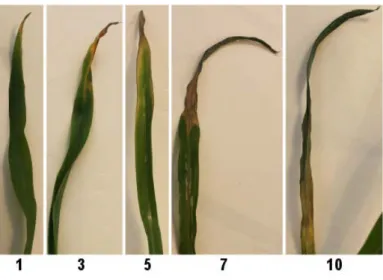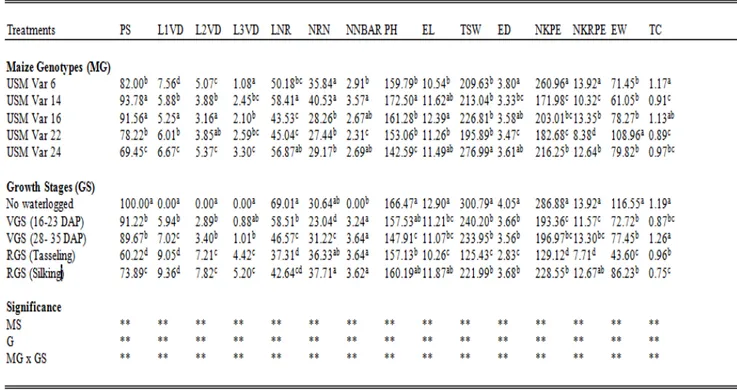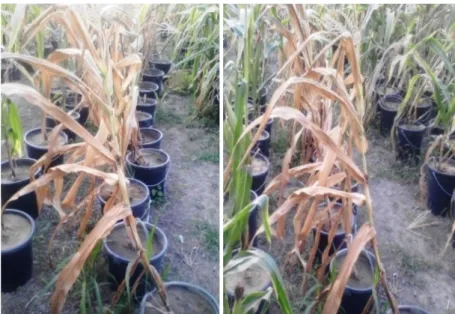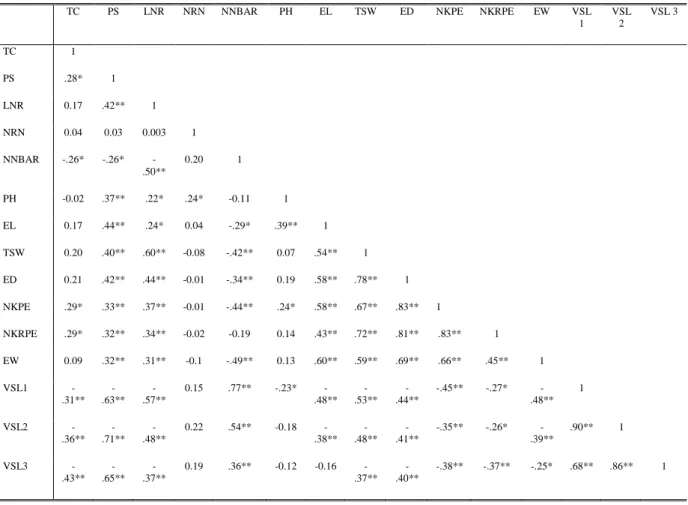(IJSBAR)
ISSN 2307-4531
(Print & Online)
http://gssrr.org/index.php?journal=JournalOfBasicAndApplied
---
112
Waterlogging: It’s Effects on Different White Maize
Genotypes
Jerald Anthony C. Esteban
a*, Solilap Edwin L.
baInstructor, College of Agriculture, Compostela Valley State College, Compostela, Compostela Valley,
Philippines
b
Instructor, Faculty of Agriculture Department, College of Agriculture and Related Sciences, University of Southeastern Philippines, Apokon, Tagum City, Philippines
aEmail: [email protected]
Abstract
Enough supply of soil water is essential for growth and development of the maize. However, excess water from erratic rain patterns and climate change can cause waterlogging. Hence, this study was conducted to investigate the effects of the seven-day waterlogged condition in different white maize genotypes, determine the sensitive growth stage that negatively affects the growth and yield potential of maize and identify morphological and physiological traits of maize conferring tolerance to waterlogging. USM Var 14 and 16 obtained the highest rate of survival percentage and possessed higher number of nodes that bear adventitious roots. Meanwhile, USM Var 6 obtained the highest total chlorophyll which able to produced bigger ear diameter, more number of kernels and kernel rows per ear. In addition, total chlorophyll shows a positive and significant correlation with number of kernels, kernels row per ear and percentage survival. Length of nodal roots also shows a significant and positive correlation with survival percentage and yield components. Thus, maize with higher total chlorophyll and longer nodal roots has a higher chance of survival and higher yield components when subjected to waterlogged condition. USM Var 6, 14 and 16 have the potential to be the parent materials for breeding purposes in temporary waterlogged condition which is caused by erratic rain patterns and climate changes.
--- * Corresponding author.
113
Meanwhile, when tasseling stage experience waterlogging it’s significantly decreased the growth and yield potential of the white maize. Tasseling was the most vulnerable stage of white maize when experience seven-day waterlogged condition.
Keywords: genotypes; maize; phenotypes; waterlogging.
1.Introduction
Maize or corn (Zea mays L.) assumes its cultivation under much diverse agro-climatic zones extending from
subtropical to cooler temperate regions. Therefore, inevitably, the crop remains open to varied types of biotic as well as abiotic stresses. Among the various abiotic stresses, Excess Soil Moisture (ESM) stress caused by temporary waterlogging, due to heavy rains or high ground water table or heavy soil texture is one of the most important constraints for maize production and productivity in Asian regions [1].
Waterlogging conditions drastically alter the soil properties. These changes in soil adversely affect the capability of a plant to survive in such situations [2]. Plants growing under waterlogged conditions are affected by numerous stresses. For example, restrictions to gas insufficiency of mineral nutrients and microelements poisoning [3]. Waterlogging affects 10% of the global land area [3] and is one of the most important constraints imposed on agricultural crop production. The yield penalty resulting from waterlogging may vary between 15% and 80%, depending on the species, soil type and duration of the stress [4]. In South East Asia alone, about 15% of total maize growing area is affected by floods and waterlogging. The maize crop suffers badly whenever it encounters temporary ESM conditions during the monsoon season or grown in poorly drained converted paddy fields after a rainy season rice crop [5].
In monsoon sowing, it is difficult to avoid waterlogging at one or other stages of crop growth due to erratic rains. The main effect induced by waterlogging condition is oxygen deficiency in plant root caused to be anaerobic respiration which cannot supply enough energy to move nutrients from soil solution into plant shoot; consequently growth is quite inhibited culminated in yield reduction, respectively. The tolerance of maize genotypes towards this particular type of stress varies considerably and is highly influenced by the degree of stress and the genotype of the plant [6]. A major portion of country’s economy based upon cash crops, waterlogging can decline the overall yield of crops ultimately leading to financial loss. Hence, there is a need to screen the collected germplasm with adaptive potential to perform well under temporary waterlogged conditions and for identifying the morphological and physiological traits conferring resistance to waterlogging and incorporating these traits in well adapted genotypes to end up with promising material. Thus, this study aims to determine the effects of waterlogging in different maize genotypes, identify the sensitive stage that negatively affects the growth and yield potential of maize and identify the morphological and physiological traits of maize conferring tolerance to waterlogging.
2.Materials and Methods
Maize germplasm comprising five white genotypes were used as factor A and growth stages of maize as factor B for this experiment. This study was laid out in factorial design arranged in Randomized Complete Block
114
Design and replicated three times. Pot experiment was conducted at the research area of the College of Agriculture and Related Sciences, University of Southeastern Philippines, Tagum-Mabini Campus, Pindasan, Mabini, Compostela Valley Province, Philippines from November 2015 to March 2016. Different genotypes of maize were planted in the plastic pots (30x30cm) containing ordinary garden soil. Soil was initially sieved through mesh with fine mesh size (2x2cm) to remove stones, pebbles and other materials that hinder the proper growth of plant and weighing equal quantity of soil (18kg) was maintained in the pot in order to maintain same moisture level in each pot. Proper fertilization was applied to the plant based on the result of the soil analysis. The entire quantity of phosphorus and potassium and one half of the total nitrogen was applied as basal and the remaining nitrogen was applied in two equal splits at knee height and at flowering stages. Seven-day of waterlogged condition was done at the different growth stages of maize genotypes and three centimetres (3cm) of water level above the top soil of the plant was maintained through continuous application of water. After exposure to waterlogging, pounding water was drained out from the pots. For recording of observations, different maize genotypes were randomly selected from each treatment per replication. Regular methods of recording data were used in taking the survival percentage, plant height and yield component parameters. However, length of nodal roots, nodal root number and number of nodes bearing adventitious roots was based on the following the methods developed by Mcfarlane and his colleagues [7]. Maize plants were scored for
visual damage using a scoring system specifically developed for waterlogged study by Campbell, M. T and his
colleagues, 2015. The oldest leaf (Leaf 1), middle leaf (Leaf 2) and the youngest leaf (Leaf 3) of maize genotypes were used for visual scoring and it was done after seven-day waterlogged condition in different maize genotypes. Scoring range was set from 0–10 and lower scores correspond to higher tolerance based on visual phenotyping (Figure 1). Total chlorophyll of different white maize genotypes were taken from the youngest fully expanded leaf of 10 sample plants at 2:00p.m. to 3:00p.m. The sample was immediately delivered to Davao Trade Exponents, Inc. Soil Analytical Laboratory, Highland Banana Corp. Compound, Giuanga, Tugbok District, Davao City for the laboratory analysis and this was expressed in mg/g FW (Fresh Weight). The differences among treatment means were compared using Tukey’s Honest Significance Difference at 5% level of probability and growth and yield parameters were correlated using Pearson correlation.
Figure 1: Graphical summary of visual scoring system used for phenotypic evaluation of submergence and dark-induced senescence
115
3.ResultsTable 1 presents the phenotypic and physiological response of different white maize genotypes and growth stages under the seven-day waterlogged condition. Results show that different white maize genotypes were affected by waterlogged condition for seven days.
Effects on Growth Parameters
USM Var 14 obtained the highest percentage survival with the mean of 93.78% and followed by USM var. 16. USM Var 14 was able to survive because it possessed longer nodal roots, most nodal roots number and nodes bearing adventitious roots that helped the variety to survived for seven-day waterlogged condition. In addition, USM Var 14 obtained the highest plant height compared with the other maize genotypes. Furthermore, USM Var 14 and 16 got lowest visual score rating (leaf 1, leaf 2 and leaf 3) which correspond to higher degree of tolerance for submergence. This is in congruence with the findings of Purvis and Williamson [8] who reported that plants might be able to survive a flooded environment by increasing the number of their adventitious roots. On the other hand, the survival percentage of white maize genotypes is also affected by waterlogging on different growth stages. Tasseling stage obtained the lowest percentage survival among growth stages of white maize genotypes (Figure 2). In addition, leaf visual score damage of leaf 1, 2 and 3 on tasseling stage got the highest score rating which represents the lower degree of tolerance for survival. In addition, seven-day waterlogged condition reduced the plant height of maize at any growth stages. Similar result was obtained by Setter and Waters [3] that waterlogging reduce plant growth at any growth stage. It shows that VGS (28-35 DAP) got the lowest plant height compared with no waterlogged condition. Furthermore, VGS (28- 35 DAP) obtained the lower number of nodal root and length of nodal roots compared. According Dong et al. [9] that prolonged waterlogging will result in death of the root and also restricts the wheat plant’s uptake of nutrients by reducing transpiration and restricting root function which reduces plant height in sorghum. Furthermore, numerous phenotype-based indices have been used both in genetic studies [10] and in breeding programs [4]. However, main methods used are indices based on leaf chlorosis [11] and germination ability [12].
Effects on Yield Components and Total Chlorophyll
USM Var 16 obtained the longest ear length and lower visual score damage on leaf (1 to 3) which indicates that lower visual score damage has a higher total chlorophyll. USM Var 24 obtained the highest thousand seed weight and followed by USM Var 16 with mean of 276.99 and 226.81 g, respectively. However, USM Var 24 got the lowest survival percentage and highest visual score damage among maize genotypes which indicates that USM Var 24 has lower waterlogging tolerance based on agronomic traits. Meanwhile, USM Var 6 obtained the highest total chlorophyll which able to produce bigger ear diameter, more number of kernels and kernel rows per ear. In addition, USM Var 6 obtained the highest total chlorophyll which able to produce bigger ear diameter, more number of kernels and kernel rows per ear. Furthermore, total chlorophyll shows a positive and significant correlation with number of kernels, kernels row per ear and percentage survival. On the other hand, tasseling obtained the lowest ear length, (Figure 3) number of kernels, kernel rows per ear and highest visual score damage resulting to lower content of chlorophyll. These results agree with the findings of Lone and Warsi
116
[1] where crop at tasseling stage experience water submergence will decrease the yield of the crop. Nutrient uptake and photosynthesis rate are also reduced in maize plants [13] Moreover, leaf photosynthetic rate in waterlogged sorghum is partly regulated by chlorophyll [14] Furthermore, reduction in chlorophyll content and leaf senescence occur and shrinking of leaves may also complete inhibition of photosynthesis [15] which could be the cause of the decreased of accumulation of carbohydrates in kernel maize resulting to lower kernel weight. In addition, Palwadi and Lal [16] studied that there was significant reduction in total number of ears per hectare number of rows per ear, number of grain per row and 1000-grain weight of maize due to forty-eighty hours of waterlogging. Also, flowering of maize crop for forty-eight hours at seedling, knee height, tasselling and milk-ripe stages decreased grain yield by 59%, 35%, 63% and 41%, respectively. Furthermore, overall grain production of maize genotypes was affected by widening of anthesis silking interval resulted in poor pollination [1].
Table 1: Phenotypic and physiological responses of different white maize genotypes and growth stages under the seven-day waterlogged condition.
*,**Significant at p<0.05 or 0.01, respectively and ns; not significantly different at 0.05 of probability. Values followed by the same letter in the same column are not significantly different at 0.05 and 0.01 probability. PS: Percentage Survival. L1VD: Leaf 1 Visual Damage. L2VD: Leaf 2 Visual Damage. L3VD: Leaf 3 Visual Damage. LNR: Length of Nodal Root. NRN: Nodal Root Number. NNBAR: Number of Nodes Bearing Adventitious Roots: PH: Plant Height. EL: Ear Length. TSW: Thousand Seed Weight. ED: Ear Diameter. NKPE: Number Kernel Per Ear. NKRPE: Number of Kernel Rows Per Ear. EW: Ear Weight. TC: Total Chlorophyll. VGS: Vegetative Growth Stage. RGS: Reproductive Growth Stage.
117
Intercharacter Correlation
Pearson correlations were calculated between growth and yield parameters of different white maize genotypes
under seven-day waterlogged condition (Table 2). Results show that total chlorophyll was positively and
significantly correlated with the percentage survival, number of kernels and kernel rows per ear. In addition, length of nodal roots also shows a significant and positive correlation with survival percentage and yield components parameters. Thus, higher total chlorophyll and longer nodal roots has a higher chance of survival and higher yield components when subjected to seven-day waterlogged condition
Figure 2: Effects on tasseling stage when subjected to seven-day waterlogged condition.
118
4.ConclusionThe results demonstrated that seven-day waterlogging decreased the growth and yield performance of different white maize genotypes.
Maize is vulnerable to waterlogging at any growth stages but when tasseling stage experience the seven-day waterlogged condition it’s significantly decreased the growth and yield performance of different white maize genetypes. High level of total chlorophyll and the longer length of nodal roots can be good criterion for screening the tolerant maize species for temporary waterlogged condition.
Table 2: Correlation matrix of growth and yield parameters of different white maize genotypes
TC PS LNR NRN NNBAR PH EL TSW ED NKPE NKRPE EW VSL
1 VSL 2 VSL 3 TC 1 PS .28* 1 LNR 0.17 .42** 1 NRN 0.04 0.03 0.003 1 NNBAR -.26* -.26* -.50** 0.20 1 PH -0.02 .37** .22* .24* -0.11 1 EL 0.17 .44** .24* 0.04 -.29* .39** 1 TSW 0.20 .40** .60** -0.08 -.42** 0.07 .54** 1 ED 0.21 .42** .44** -0.01 -.34** 0.19 .58** .78** 1 NKPE .29* .33** .37** -0.01 -.44** .24* .58** .67** .83** 1 NKRPE .29* .32** .34** -0.02 -0.19 0.14 .43** .72** .81** .83** 1 EW 0.09 .32** .31** -0.1 -.49** 0.13 .60** .59** .69** .66** .45** 1 VSL1 -.31** -.63** -.57** 0.15 .77** -.23* -.48** -.53** -.44** -.45** -.27* -.48** 1 VSL2 -.36** -.71** -.48** 0.22 .54** -0.18 -.38** -.48** -.41** -.35** -.26* -.39** .90** 1 VSL3 -.43** -.65** -.37** 0.19 .36** -0.12 -0.16 -.37** -.40** -.38** -.37** -.25* .68** .86** 1
* Correlation is significant at the 0.05 level (2-tailed ): ** Correlation is significant at the 0.01 level (2-tailed). PS: Percentage Survival. L1VD: Leaf 1 Visual Damage. L2VD: Leaf 2 Visual Damage. L3VD: Leaf 3 Visual Damage. LNR: Length of Nodal Root. NRN: Nodal Root Number. NNBAR: Number of Nodes Bearing Adventitious Roots: PH: Plant Height. EL: Ear Length. TSW: Thousand Seed Weight. ED: Ear Diameter. NKPE: Number Kernel Per Ear. NKRPE: Number of Kernel Rows Per Ear. EW: Ear Weight. TC: Total Chlorophyll.
119
AcknowledgmentsThe researcher is in deep gratitude to the following individuals who paved the way for the fulfillment of the study: To Prof. Edwin L. Solilap, Dr. Larry V. Aceres, Dr. Cesar A. Limbaga, Jr. and Prof. Reynaldo S. Duran for the assistance, suggestion, correction, encouragement and for sharing their brilliant ideas in improving the present investigation.
References
[1] Lone A. A. And M. Z. K. Warsi.. Response of maize (zea mays l.) To excess soil moisture (esm)
tolerance at different stages of life cycle. Botany Research International 2 (3): 211-217, 2009 ISSN 2221-3635 © IDOSI Publications. 2009.
[2] Dat, J., N. Capelli, H. Folzer, P. Borgead And P.M. Bado.Sensing and signaling during plant flooding. Plant physiology and biochemistry 42: 273-282. 2004
[3] Settler, T.L. And I. Waters. Reviews of prospects for germplasm improvement for water logging tolerance in wheat, barley and oats. Plant Soil 253: 1- 34. 2003.
[4] Zhou, M. Z. Improvement of plant waterlogging tolerance. In: Mancuso S, Shabala S, eds. Waterlogging signalling and tolerance in plants. Heidelberg, Germany: Springer-Verlag, 267–285. 2010.
[5] Shimizu, N. M.Corn cultivation in converted paddy fields in Japan. Extension Bulletin ASPA-Food and
Water Centre. pp: 319-315. 1992.
[6] Torbert, H. A., R. G. Hoeft, R. M. Vanden-Heuvel, R. L. Mulvancy And S.E. Hollonger. Short term excess water impact on corn yield and nitrogen recovery. J. Prod Agril., 6: 337-344. 1993.
[7] Mcfarlane, N.M., T. A. Ciavarella And K. F. Smith. The effects of waterlogging on growth,
photosynthesis and biomass allocation in perennial ryegrass (Lolium perenneL.) genotypes with
contrasting root development. J. Agric. Sci., 141: 241-248. 2004.
[8] Purvis, A. C. And R. E. Williamson. Effects of flooding and gaseous composition of the root environment on growth of corn. Agron. J. 64:674-678. 1972.
[9] Dong, J. G., Z. W. Yu And S. W. Yu.Effect of increased ethylene production during different periods
on the resistance of wheat plants to waterlogging. Acta.Phyto.physiologiaSinica, 9: 383-389. 1983
[10] Parelle J, Dreyer E, Brendel O. Genetic variability and determinism of adaptation of plants to soil waterlogging. In: Mancuso S, Shabala S, eds. Waterlogging signalling and tolerance in plants. Heidelberg, Germany: Springer-Verlag, 241–265. 2010.
120
Jpn J. Breed. 40, 361–366.
[12] Takeda, K.; And Fukuyama, T. Tolerance to pre-germination flooding in the world collection of barley varieties. Barley Genet. 1987, V, 735–740. 1987.
[13] Jensen, C.R., L.H. Stolzy And J. Letey. 1967. Tracer studies of oxygen diffusion through roots of barley, corn and rice. Soil Sci., 103: 23.
[14] Promkhambut, A., A. Younger, A. Polthanee And C. Akkasaeng. Morphological and physiological responses of sorghum (Sorghum bicolor L. Moench) to waterlogging. Asian Journal of Plant Sciences 9 (4): 183-193, 2010 ISSN 1682-3974. 2010.
[15] Drew, M.C. and L.R. Saker. Ion transport to the xylem in aerenchymatous roots of Zea mays L. Journal of Experimental Botany, 37: 22-33. 1986.
[16] Palwadi, H.K. And B. Lal. Note of susceptibility of maize to water logging at different growth stages. Pantnagar J. Res., 1: 141-142. 1976



